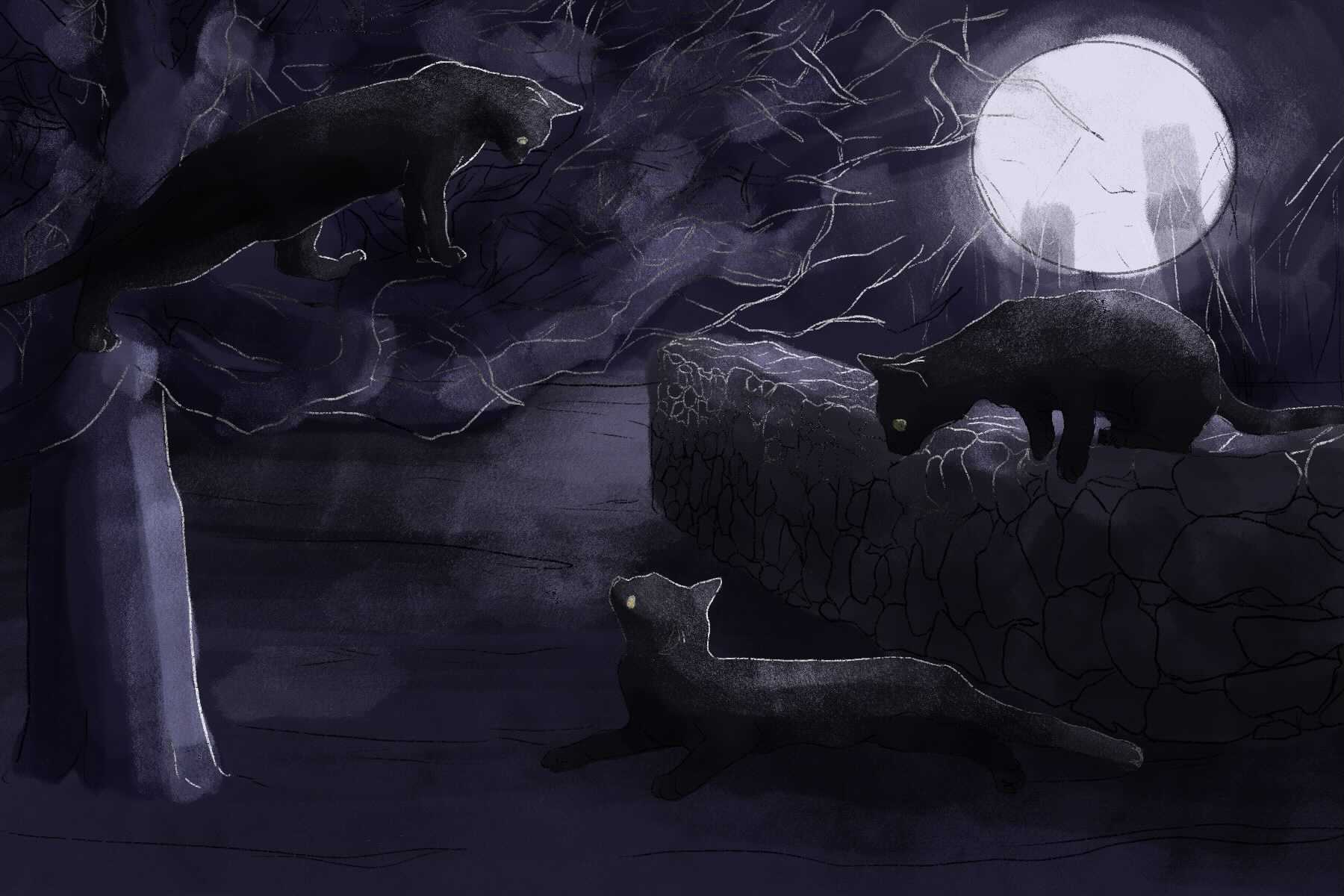While the domestication and selective breeding of dogs over thousands of years has created at least 360 breeds recognized by the World Canine Organization, cats have not evolved much from their wild ancestors. This is due to the fact that cats were not intentionally domesticated by humans like dogs were; instead, they domesticated themselves and worked their way into human homes — and hearts — through mutual benefit.
They first joined ancient households in the Fertile Crescent (what now covers modern-day Iraq, Syria, Lebanon, Palestine, Israel, Jordan and Egypt) about 8,000 to 10,000 years ago, likely attracted by the rodents and prey that fed off early farmers’ crops. Since then, cats’ semi-domestication has been documented in art and artifacts from ancient paintings to the modern selfie, and they have become inseparable members of human civilization.
Although there is less distinction between cat breeds, black cats in particular have always captured the human imagination. Whether Bombay, bobtail or shorthair, black cats have become iconic symbols of the spooky, mysterious and supernatural. But long before they became cute Halloween decorations or last-minute costumes, they’ve held a special place in myth and legend. From The Temple of Bastet to Spirit Halloween, here’s what you should know about the beliefs surrounding black cats.
Lucky and Lucky in Love
Cats of all kinds were revered by ancient Egyptians of the Old and Middle Kingdoms for their association with certain deities. While it’s tempting to overgeneralize over 3,000 years of human history, it’s safe to say that based on their presence in hieroglyphics, obelisks and human tombs, cats held notable status for those living along the Nile.
Ancient Egyptians didn’t generally worship animals, but they did celebrate them as divine aspects of their gods. They celebrated cats for their resemblance to Bastet, the goddess of home, fertility and childbirth who protected the household from evil and disease, as well as Sekhmet, another fierce, feline goddess tied to both warfare and healing. To an enemy, Sekhmet was terrifying, but for friends, she could stop plague, cure disease and act as a patron of physicians and healers.
In the eighth century, sailors continued to use cats for luck and protection against disease, bringing them on ships to hunt mice the same way early agricultural societies let cats into their homes to deal with vermin. Sailors would also monitor cat behavior to predict weather patterns, and of course, their cats provided the companionship they’re known for today.
Black naval cats became known as a symbol of good luck and were brought on board to ensure safe passage. One famous sailor-cat, “Blackie,” lived on the HMS Prince of Wales during World War II. Blackie achieved worldwide fame after the ship bore Prime Minister Winston Churchill across the Atlantic to NS Argentia, Newfoundland, where he held a secret meeting with United States President Franklin D. Roosevelt that resulted in the signing of the Atlantic Charter. As Churchill stepped off the ship, he stopped to bid farewell to Blackie. This was a moment immortalized through photography.
Other famous black “navy cats” include Tiddles — who was born on the HMS Argus, became the official Captain’s Cat on HMS Victorious and traveled over 30,000 miles during his service — and Unsinkable Sam, who earned his nickname after surviving three separate shipwrecks. Pirates were also known to buy into the black cat’s ability to ensure good or bad luck. Their beliefs, however, changed depending on a cat’s actions; they believed it was bad luck if a black cat walked toward you, good luck if they walked away and an impending shipwreck if a cat boarded then jumped off a ship.
Outside of maritime lore, a black cat’s direction and movements can signal good luck in multiple countries. In Scotland, it’s commonly believed that their arrival on your doorstep signals prosperity, and it’s good luck for one to cross your path in England and Ireland. As for the potential for romance, black cats might be a boon to your dating life. In Japan, it’s believed single women who own them attract more suitors. In Great Britain’s English Midlands, they can be wedding gifts, believed to bring good luck and happiness to the bride.
(Un)lucky in the Dark Ages
Although sailors reclaimed them as a good luck charm in World War II, black cats’ reputation took a near-fatal hit in the Middle Ages. Superstitions associating them with the devil, demon worship and witchcraft took root and signaled the beginning of a dark age for the creatures.
Celtic mythology told of Cat Sìth, or Sídh, a black fairy with a white spot on its chest that could steal souls or shift nine times into human form. Some medieval Europeans believed cats could steal souls and perform similar acts credited to Satan. In the 12th century, some believed the devil took the form of a black cat in satanic rituals.
This time period also shows the darker history behind the modern stereotype of the “crazy cat lady” when single, elderly women — many of whom kept cat companions — were accused of being witches. These women and their pets fell victim to the Catholic Church’s crusade against supposed heresy that culminated in 1233’s “Vox in Rama,” which was Pope Gregory IX’s papal decree condemning the Luciferianism that allegedly permeated Germany.
Black cats’ previous ties to ancient Egypt and enduring importance in Arab and eventually Islamic culture is based in part on the Prophet Muhammad’s fondness for cats, proven by his pet cat Muezza. However, medieval Christians’ suspicion of the harmless felines was only furthered.
Tragically, people began to kill or torture black cats. Medieval Europeans would commonly engage in disgusting “zoosadistic” acts for entertainment, believing it would help break curses and spells. The heresy trials that accompanied the Vox in Rama grew into a terrifying precursor to the Inquisition, during which tens of thousands of people were put to death. The massacre of cats in the early 13th century portended this deeply disturbing and violent period in Christian history.
Cat massacres were so pervasive that some believed the drop in the cat population and subsequent increase in mice helped contribute to the Black Death, the plague that spread in the 14th century and killed a third of the entire European population. While cats were thankfully not hunted to extinction in Europe at this time, and their drop in numbers is not enough to account for the plague, it seems that getting on cats’ bad side still backfired karmically. As the 2019 Netflix documentary states, “Don’t F**k With Cats.”
A Witch’s Best Friend
The persecution of black cats and their owners continued in Salem with the rise of Puritan culture and the notorious Salem Witch Trials. Elsewhere, they were sometimes burned on Fat Tuesday, or the Shrove, before the beginning of Lent to protect homes from fire. Their place as the “Witch’s familiar,” a witch’s psychically-linked magical assistant who takes the form of a small animal, cemented itself.
At this time, the popular Halloween iconography we see now, such as a black cat riding on a witch’s broom, was spread and retold with genuine fear and suspicion. While it’s horrifying to look back at the pointless animal cruelty these superstitions gave rise to, it’s fascinating to trace our modern Halloween-obsessed pop culture back to its unsavory roots and see how far black cats have come in the Western world. As a modern witchcraft renaissance sweeps the U.S., it’s easy to forget the centuries of history behind this phenomenon.
Adopt a Black Cat
From Unsinkable Sam to smart-talking Salem in “Sabrina the Teenage Witch” to Binx in “Hocus Pocus,” black cats continue to arrest our hearts and minds thousands of years after the first Felis silvestris decided to befriend people.
Despite the modern shift away from suspicion toward black cats, they are still adopted at lower rates than cats of other colors. According to the RSPCA, “70 percent of the cats in our care will be either black or black-and-white.” This can be because black cats might not photograph as well, can be harder to differentiate without as many distinct markings or because of lingering cultural superstitions. Even today, some shelters will not allow black cats to be adopted in the month of October for fear they might be harmed.
Efforts to disrupt the year-round adoption discrepancy include designating Aug. 17 as Black Cat Appreciation Day in the United States. But animal lovers can always show their love for these lovely and mysterious-looking creatures, whether it’s August or not.
Overall, cats are scientifically proven to be great for your health by lowering stress and decreasing the chance of diseases associated with said stress. So, if you ever find yourself looking for your own feline companion, consider finding a lovely black cat to take home. You’ll be happier (and luckier) for it.

















